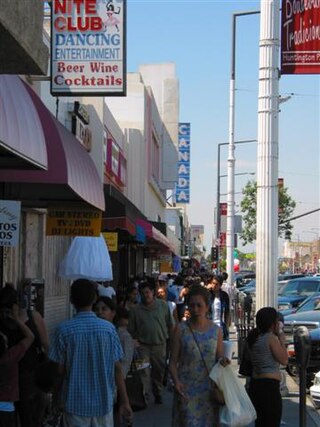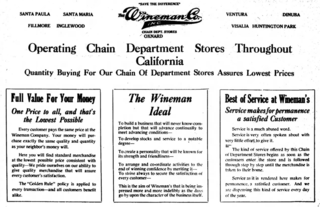
The Pacific Electric Railway Company, nicknamed the Red Cars, was a privately owned mass transit system in Southern California consisting of electrically powered streetcars, interurban cars, and buses and was the largest electric railway system in the world in the 1920s. Organized around the city centers of Los Angeles and San Bernardino, it connected cities in Los Angeles County, Orange County, San Bernardino County and Riverside County.

Del Amo Fashion Center is a three-level regional shopping mall in Torrance, California, United States. It is currently managed and co-owned by Simon Property Group.

Bullock's was a chain of full-line department stores from 1907 through 1995, headquartered in Los Angeles, growing to operate across California, Arizona and Nevada. Bullock's also operated as many as seven more upscale Bullocks Wilshire specialty department stores across Southern California. Many former Bullock's locations continue to operate today as Macy's.
I. Magnin & Company was a San Francisco, California-based high fashion and specialty goods luxury department store. Over the course of its existence, it expanded across the West into Southern California and the adjoining states of Arizona, Oregon, and Washington. In the 1970s, under Federated Department Stores ownership, the chain entered the Chicago, Illinois, and Washington, DC, metropolitan areas. Mary Ann Magnin founded the company in 1876 and named the chain after her husband Isaac.
The Broadway was a mid-level department store chain headquartered in Los Angeles, California. Founded in 1896 by English-born Arthur Letts Sr., and named after what was once the city's main shopping street, the Broadway became a dominant retailer in Southern California and the Southwest. Its fortunes eventually declined, and Federated Department Stores bought the chain in 1995. In 1996, Broadway stores were either closed or converted into Macy's and Bloomingdales.

May Company California was a chain of department stores operating in Southern California and Nevada, with headquarters in North Hollywood, California. It was a subsidiary of May Department Stores and merged with May's other Southern California subsidiary, J. W. Robinson's, in 1993 to form Robinsons-May.

Hartfield-Zodys was an American retail corporation begun in 1960. It operated the Hartfield chain of women's ready-to-wear apparel in the Los Angeles area, and starting in 1960, the Zodys chain of discount retail stores (1960–1986), which operated locations in California, Arizona, Nevada, New Mexico, and Michigan.

Pacific Boulevard is a street and principal commercial thoroughfare in the city of Huntington Park, California and the Los Angeles County neighborhood of Walnut Park. It runs from Vernon and Santa Fe Avenues in Vernon to Cudahy Street in Walnut Park before changing to Long Beach Boulevard. The Pacific Boulevard commercial district is the third highest grossing commercial district in the County of Los Angeles. The Christmas Lane Parade, seen in millions of homes via television throughout the United States and parts of Europe, has run down Pacific Boulevard since 1946. As many as 300,000 people attend the annual Carnaval Primavera held on Pacific Boulevard each year. Pacific Boulevard is well known to Latino residents of the L.A. area, and a magnet for commerce, culture, and night life.

The Los Angeles Pacific Railroad (1896−1911) (LAP) was an electric public transit and freight railway system in Los Angeles County, California. At its peak it had 230 miles (370 km) of track extending from Downtown Los Angeles to the Westside, Santa Monica, and the South Bay towns along Santa Monica Bay.
Akron Stores or The Akron was a Southern California-based imported goods and home decorating department store retail chain established in 1947 and was known to carry unusual merchandise, mostly imports. The chain had over 24 stores throughout Southern California from San Diego to San Francisco before it was forced to close in 1985.
Haggarty's was a department store chain founded in Los Angeles in 1906, which closed in May 1970 due to not keeping up with fashion trends and a resulting $4.4 million in debts. It had more than a dozen branches at its peak.

Harris & Frank was a clothing retailer and major chain in the history of retail in Southern California, which at its peak had around 40 stores across Southern California and in neighboring states and regions. Its history dates back to a clothing store founded by Leopold Harris in Los Angeles in 1856 near the city's central plaza, only eight years after the city had passed from Mexican to American control. Herman W. Frank joined Harris in partnership 32 years later in 1888.
Nahas was a chain of department stores owned by A. S Nahas, operating in Greater Los Angeles, carrying clothing, household goods and electronics. They also acquired Rathbun's department store at 5311 Lankershim Blvd. in North Hollywood and cobranded it "Nahas Rathbuns" before the branch closed in 1980. The remaining Nahas stores closed in 1981–2.

Jacoby Bros. was one of Los Angeles' largest dry goods retailers in the 1880s and 1890s, developing over the decades into a department store, which closed in the late 1930s.

7th Street is a street in Los Angeles, California running from S. Norton Ave in Mid-Wilshire through Downtown Los Angeles. It goes all the way to the eastern city limits at Indiana Ave., and the border between Boyle Heights, Los Angeles and East Los Angeles.

Orange County Plaza, later Garden Grove Mall, Garden Promenade, now The Promenade at Garden Grove, was, upon its expansion in 1959, with sixty stores, the largest shopping center in Orange County, California, and at the time billed itself as "Orange County's first regional shopping center". However, Anaheim Plaza had in fact already opened In 1955, four years prior, and had an anchor department store.

Boadway Bros. or Boadway's was a chain of upscale department stores in Southern California and New Mexico during the 1910s and 1920s, which started with a single store in Pasadena carrying furniture.

Wineman's was a chain of department stores in Southern and Central California which started in Ventura in 1890, and later became iconic local department stores of Oxnard and, later, Huntington Park.

Retail in Southern California dates back to its first dry goods store that Jonathan Temple opened in 1827 on Calle Principal, when Los Angeles was still a Mexican village. After the American conquest, as the pueblo grew into a small town surpassing 4,000 population in 1860, dry goods stores continued to open, including the forerunners of what would be local chains. Larger retailers moved progressively further south to the 1880s-1890s Central Business District, which was later razed to become the Civic Center. Starting in the mid-1890s, major stores moved ever southward, first onto Broadway around 3rd, then starting in 1905 to Broadway between 4th and 9th, then starting in 1915 westward onto West Seventh Street up to Figueroa. For half a century Broadway and Seventh streets together formed one of America's largest and busiest downtown shopping districts.














